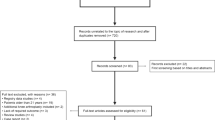Abstract
Introduction
The aim of our study was to investigate a potential influence of elevated serumcobalt and serumchromiumlevels on renal function at minimum 10 years after implantation of a metal-on-metal hip.
Materials and methods
Between November 1992 and June 1994 98 patients (44 m, 54 f) with an average age of 56 (22–79) years received a metal-on-metal bearing Metasul™. At the time of the 10-year follow-up, 15 patients had died and 8 were lost to follow-up. The remaining 75 patients had laboratory analysis including serumcreatinine and full blood cell count as well as chromium and cobalt serumlevels.
Results
Ten years postoperatively the median serumcreatinine level was 0.86 (0.55–1.51) mg/dl, the serumcreatinine clearance Ccr was in the normal range. The hemogram did not differ from that measured at the time of surgery. The median serumcobalt concentration was 0.75 (0.3–50.10) μg/l and the serumchromium concentration was 0.95 (0.3–58.6) μg/l, 10 years postoperatively.
Conclusion
Our long-term data do not show any influence of serum cobalt or chromium concentrations on renal function following total hip arthroplasty.
Similar content being viewed by others
References
Allen MJ, Myer BJ, Millett PJ (1997) The effects of particulate cobalt, chromium and cobalt–chromium alloy on human osteoblast-like cells in vitro. J.Bone Joint Surg (Br) 79:475–482
Anderson RA, Bryden NA, Polansky MN (1997) Lack of toxicity of chromium chloride and chromiume picolinate in rats. Am Coll Nutr 16(3):273–279
Anissian L, Stark A, Gustafson A (1999) Metal-on-Metal bearing in hip enerates 100-fold less wear debris than metal-on-polyethylene. Acta Orthop Scand 70:578–582
Back D, Young D, Shimmin A (2005) How do serum cobalt and chromium levels change after metal-on-metal hip resurfacing? Clin Orthop 438:177–191
Barceloux D (1999) Chromium. Clin Toxicol 37:173–194
Barceloux D (1999) Cobalt. Clin Toxicol 37:201–216
Black J (1988) Does corrosion matter? J.Bone Joint Surg (Br) 70(4):517–520
Brodner W, Grohs J, Bitzan P (2000) Serum Cobalt, serum chromium levels in two patients with chronic renal failure and total hip arthroplasty with metal-on-metal articulations. Z Orthop 138:425–430
Brodner W, Bitzan P, Meisinger V (2003) Serum cobalt levels after metal-on-metal total hip arthroplasty. J.Bone Joint Surg (Am) 85:2168–2173
Clarkson T (1979) Effects-general principles underlying the toxic action of metals. In: Friberg L, Norberg G, Vouk V (eds) Handbook on the toxicology of metals. Elsevier/North-Holland Biomedical Press, Amsterdam, New York, p 215
Door L, Wan Z, Longjohn D (2000) Total hip arthroplasty with use of the Metasul metal-on-metal articulation. J.Bone Joint Surg (Am) 82:789–798
Elinder C, Friberg L (1979) Cobalt. In: Friberg L, Norberg G, Vouk V (eds) Handbook on the toxicology of metals. Elsevier/North-Holland Biomedical Press, Amsterdam, New York, pp 399–410
Friberg L, Vouk V (1979) Assessment of risk for carcinogenic effects. In: Friberg L, Norberg G, Vouk V (eds) Handbook on the toxicology of metals. Elsevier/North-Holland Biomedical Press Amsterdam, New York, Oxford, p S.214
Friberg L, Vouk V (1979) Dose-response and dose-effect in human and animals. In: Friberg L, Norberg G, Vouk V (eds) Handbook on the toxicology of metals. Elsevier/North-Holland Biomedical Press, Amsterdam, New York, p 215
Froissart M, Rossert J, Jacquot Ch (2005) Predictive performance of the modification of diet in renal disease and Cockcroft–Gault equations for estimating renal function. J Am Soc Nephrol 16:763–773
Keegan GM, Learmonth ID, Case CP (2007) Orthopaedic metals and their potential toxicity in the arthroplasty patient. A review of current knowledge and future strategies. J Bone Joint Surg (Br) 89(5):567–573
Kramer B, Bucher M, Sander P (1997) Effects of hypoxia on growth factor expression in the rat kidney in vivo. Kidney Int 51:444–447
Norman J, Clark I, Garcia P (2000) Hypoxia promotes fibrogenesis in human renal fibroblasts. Kidney Int 58:2351–2366
Schmalzried TP, Jasty M, Harris WH (1992) Periprosthetic bone loss in total hip arthroplasty. Polyethylene wear debris and the concept of the effective joint space. J Bone Joint Surg (Am) 74:849–863
Wani S, Weskamp C, Marple J (2006) Acute tubular necrosis associated with chromium picolinate-containing dietary supplement. Ann Pharmacother 40(3):563–566
Wasser W, Feldman N, D’Agati V (1997) Chronic renal failure after ingestion of over-the counter chromium picolinate. Ann Intern Med 126:410
Willert H, Bertram H, Buchhorn G (1990) Osteolysis in alloarthroplasty of the hip—the role of ultra-high-molecular weight polyethylen wear particles. Clin. Orthop 258:95–107
Author information
Authors and Affiliations
Corresponding author
Rights and permissions
About this article
Cite this article
Marker, M., Grübl, A., Riedl, O. et al. Metal-on-metal hip implants: do they impair renal function in the long-term? A 10-year follow-up study. Arch Orthop Trauma Surg 128, 915–919 (2008). https://doi.org/10.1007/s00402-007-0466-9
Received:
Published:
Issue Date:
DOI: https://doi.org/10.1007/s00402-007-0466-9




